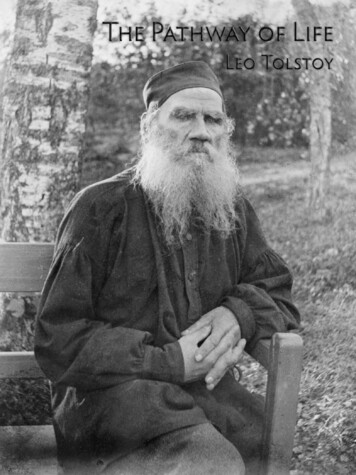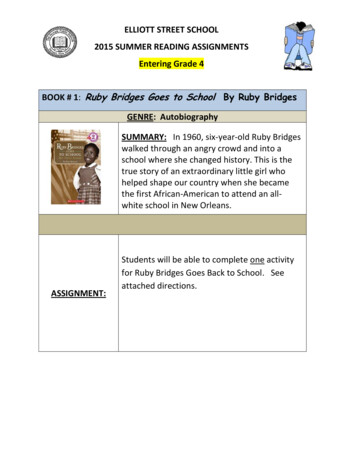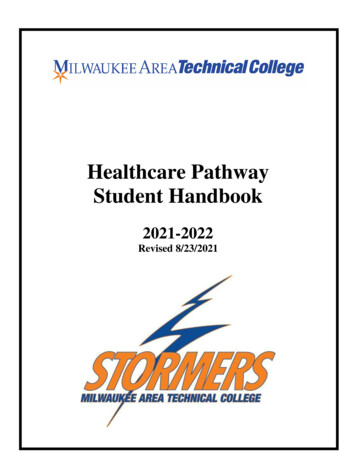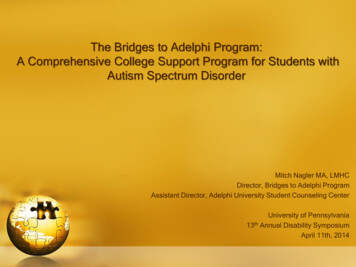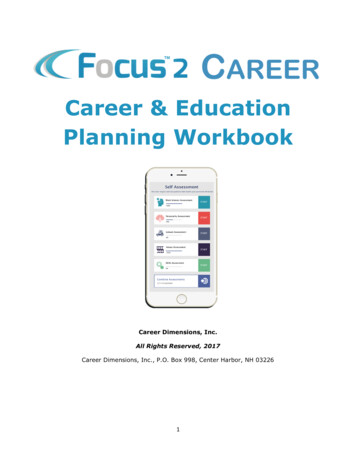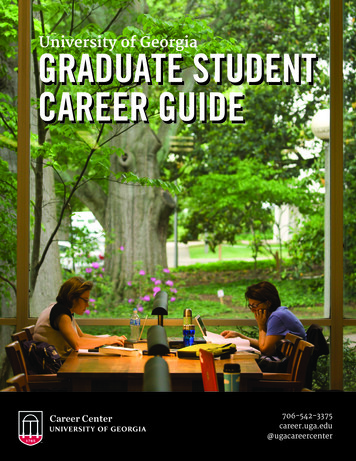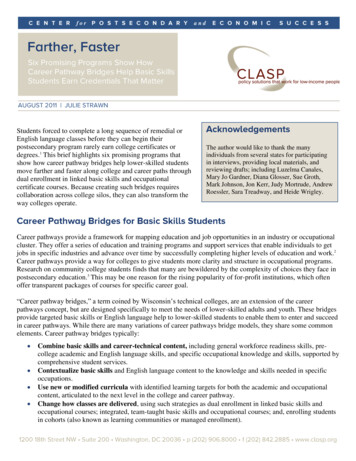
Transcription
Students forced to complete a long sequence of remedial orEnglish language classes before they can begin theirpostsecondary program rarely earn college certificates ordegrees.1 This brief highlights six promising programs thatshow how career pathway bridges help lower-skilled studentsmove farther and faster along college and career paths throughdual enrollment in linked basic skills and occupationalcertificate courses. Because creating such bridges requirescollaboration across college silos, they can also transform theway colleges operate.The author would like to thank the manyindividuals from several states for participatingin interviews, providing local materials, andreviewing drafts; including Luzelma Canales,Mary Jo Gardner, Diana Glosser, Sue Groth,Mark Johnson, Jon Kerr, Judy Mortrude, AndrewRoessler, Sara Treadway, and Heide Wrigley.Career pathways provide a framework for mapping education and job opportunities in an industry or occupationalcluster. They offer a series of education and training programs and support services that enable individuals to getjobs in specific industries and advance over time by successfully completing higher levels of education and work.2Career pathways provide a way for colleges to give students more clarity and structure in occupational programs.Research on community college students finds that many are bewildered by the complexity of choices they face inpostsecondary education.3 This may be one reason for the rising popularity of for-profit institutions, which oftenoffer transparent packages of courses for specific career goal.―Career pathway bridges,‖ a term coined by Wisconsin’s technical colleges, are an extension of the careerpathways concept, but are designed specifically to meet the needs of lower-skilled adults and youth. These bridgesprovide targeted basic skills or English language help to lower-skilled students to enable them to enter and succeedin career pathways. While there are many variations of career pathways bridge models, they share some commonelements. Career pathway bridges typically:Combine basic skills and career-technical content, including general workforce readiness skills, precollege academic and English language skills, and specific occupational knowledge and skills, supported bycomprehensive student services.Contextualize basic skills and English language content to the knowledge and skills needed in specificoccupations.Use new or modified curricula with identified learning targets for both the academic and occupationalcontent, articulated to the next level in the college and career pathway.Change how classes are delivered, using such strategies as dual enrollment in linked basic skills andoccupational courses; integrated, team-taught basic skills and occupational courses; and, enrolling studentsin cohorts (also known as learning communities or managed enrollment).
Support student success through comprehensive student services, often including a point of contact whohelps students navigate through college advising and financial aid services, connects students to otherpublic benefits, and works with students to problem solve as challenges arise that could derail progress.Connect to local employer and community needs by engaging key partners in design and implementationof bridges, such as employers, unions, workforce development boards, community-based organizations andfoundations.Career pathway bridges are a relatively new approach to basic skills and career-technical education. Consequently,little independent research has been conducted on their effectiveness, though local programs report promising earlyresults. The most rigorous research to date is a 2010 study by Columbia University on the effectiveness ofWashington State’s I-BEST program, which pairs basic skills and career-technical instructors in the sameclassroom to teach integrated occupational certificate and basic skills content. The study finds that I-BESTstudents are 56 percent more likely than regular adult basic education and ESL students to earn college credit, 26percent more likely to earn a certificate or degree, and 19 percent more likely to achieve learning gains on basicskills tests—or more simply, as Washington puts it, I-BEST moves students ―farther and faster.‖4In addition to the I-BEST study,considerable research exists on individualelements of bridge programs, such as dualenrollment, contextualization, enhancedstudent services, and learning communities.5This research suggests that these can beeffective strategies for improving studentcompletion of basic skills coursework andfor increasing enrollment in and completionof college-level courses. While the impact ofany one of these strategies alone is oftenmodest, the I-BEST experience lends weightto the idea that such strategies may havemore impact when combined, as they are incareer pathway bridges.Basic skills students at all levels can benefitfrom career pathway bridges, as illustrated inMinnesota’s vision for its FastTRACinitiative (see Figure 1). At the lower levels of adult basic education and English language instruction, careerpathway bridges (sometimes called ―pre-bridges‖) tend to focus initially on career exploration and planning or onintroducing students to broad concepts, vocabulary, and career opportunities in a specific sector. For example, ahealth care pre-bridge might include medical terminology and visits to health care workplaces to learn about therange of job opportunities in that sector. These types of pre-bridges tend to be delivered solely by basic skillsinstructors, either within adult basic education (ABE) or developmental education. Higher levels of career pathwaybridges are typically more narrowly focused because their goal is to help students prepare for and succeed inspecific occupational certificate programs within a career pathway. These bridges are typically jointly planned anddelivered by basic skills and career-technical education (CTE) instructors. (For more on adult basic education,Figure 1. Minnesota FastTRAC ModelSource: Minnesota State Colleges and Universities, Minnesota Department of Employmentand Economic Development, and Minnesota Department of Education 2
developmental education, bridge programs and other basic skills innovations, see CLASP March 2011 report,Beyond Basic Skills: State Strategies to Connect Low-Skilled Students to an Employer-Valued PostsecondaryEducation.)Standardized test scores are commonly used to determine which students can be served at what level in careerpathway bridge programs. However, other factors can be equally or more important in predicting student success,such as personal motivation, financial stability, social supports, a sense of career direction, and work experiencerelevant to the occupational program.Dual enrollment career pathway bridges enable basic skills students to begin earning a postsecondary occupationalcredential right away, without having to first complete a sequence of adult basic education, English language, anddevelopmental education services. Like dual enrollment options for high school students, students enrolled in thesebridge programs work to master pre-college reading, writing, math or English language skills while also beginningtheir postsecondary program coursework. Dual enrollment career pathway bridges offer two key advantages overtraditional, sequential approaches to remediation:Students can immediately see how their basic skills class work will help them succeed in theirpostsecondary programs and, ultimately, in their careers. The basic skills curriculum is contextualizedto the occupational content covered in the postsecondary coursework. Often students use the same technicaltextbooks and technical manuals with the basic skills instructor as they use with the CTE instructor.Students can enter a program of study from the very beginning of their postsecondary experiencewhile still receiving support to improve their basic skills. New research shows that the sooner studentsenter a program of study, the more likely it is that they will complete a certificate or degree or transfer to afour-year institution. Specifically, research found that students who entered a program of study in their firstor second term were twice as successful in completing a certificate, an associate degree, or transferring asstudents who did not enter a program of study until their second year.6There are two main types of dual enrollment career pathway bridge models. Under one approach, students duallyenroll in closely linked, separately taught, basic skills and occupational certificate courses. In the other approach,basic skills content is integrated directly into an occupational certificate course, which is team taught by basicskills and CTE instructors. To be successful, both approaches require joint planning and ongoing, closecoordination between the basic skills and CTE instructors. This allows the basic skills content to be contextualizedto the occupational field and concepts to be taught in a sequence and manner that reinforce both basic skills andCTE learning targets. It is important to note that students in these kinds of dual enrollment models must meet thesame standards for adult basic education learning outcomes and for CTE education outcomes as other ABE andCTE students.Whether colleges use the paired course approach or the integrated course approach, they typically enroll studentsin cohorts and work to connect students to comprehensive services, such as financial aid, academic advising, andother supports. In practice, these two approaches are sometimes combined. For example, in many of the I-BESTprograms in Washington State, the integrated I-BEST course is paired with a linked, contextualized basic skills 3
support course that provides additional help to lower-skilled or limited English proficient students.Dual enrollment career pathway bridges are usually targeted to students with basic skills at roughly the 6th gradelevel or higher and ESL students at level three and higher. Some of these bridges require students to have a highschool diploma or GED; others do not. Bridges that require a high school credential often do so because employersin a particular industry such as health care require one. Some other industries, such as construction andmanufacturing, are more flexible. Even if not required, these models generally support students to earn a highschool credential along the way if that is their goal.Students dually enroll in closely linked, paired basicskills and occupational certificate courses. Basicskills course content is contextualized to theoccupational course material.Students enroll in courses that integrate occupationalcertificate course content with basic skills content.Students sometimes also dually enroll in a basicskills support class whose content is contextualizedto the integrated course. South Texas College, McAllen Lake Land College, Mattoon, Illinois Portland Community College, Oregon Lower Columbia College, Longview, Washington Western Technical College, La Crosse, Wisconsin Saint Paul Public Schools ABE/Hubbs AdultLearning Center, Ramsey County WIB, and St.Paul College, MinnesotaSome examples of these two approaches to career pathway bridges appear below. Many other examples can befound elsewhere, such as in resources from the Breaking Through, Shifting Gears, and California Basic Skillsinitiatives or in resources from states with extensive career pathway bridge efforts, such as Illinois, Minnesota,Washington and Wisconsin. (See the Appendix for more information.)South Texas College offers basic skills students the opportunity to earn college credits and occupationalcertificates through dual enrollment in contextualized English language and math classes, technical Spanish classes(which cover occupational knowledge and vocabulary in the students’ native language), and college-leveloccupational courses. Through this dual language bridge model, basic skills students without a high schooldiploma or GED can complete three occupational courses in the Green Construction pathways (which includeHVAC/Refrigeration, Plumbing, and Electrical). While the initial classes in the "on ramp" portion of thesepathways are noncredit, students automatically receive―I never thought I would come to school. I thought ittranscripted college credit for them upon enrolling in the nextwas too late. I didn’t think there was an opportunity forlevel up in the pathway (see Figure 2). In addition, when creditsomebody without a GED to get back into college.‖for the initial courses has been awarded, students without aGED can qualify for federal student aid through the new option- Cassandra Robles, Student, South Texas Collegeof demonstrating "Ability to Benefit" on successful completion 4
of six credits rather than through passing Ability to Benefit test (see Figure 3).7For students who have a GED or high school diploma, the college has a fourth dual language pathway in healthcare. Students move through all of these pathways in cohorts and, as they move into higher level courses in eachpathway, students also take a college success course. Recruitment for the bridges and support services for studentsare coordinated by VIDA, a community-based workforce development group. The program also includes apartnership with the local workforce board which, together with VIDA, pays the cost of tuition and fees along withother support services such as childcare, textbooks, and gas vouchers. Though these bridges are relatively new,student retention in the initial cohorts has been very high and the college hopes to expand this bridge model toother occupational programs in the future.Figure 2. South Texas College Accelerated Electrician CareerPathway (for students with a high school diploma or GED)Source: South Texas CollegeFigure 3. South Texas College Accelerated Electrician CareerPathway (for students without a high school diploma or GED,using Ability to Benefit option)Source: South Texas College 5
In the fall of 2010, Lake Land College launched aTransportation Bridge Course which helps studentswho test into developmental reading and writingsucceed in for-credit, transportation certificateprograms at the college. Students dual enroll in thisbridge course and in one of the transportation CTEprograms: Automotive Technology, AutomotiveMechanic, or the John Deere Technology program.Most of the students in the bridge to date haveenrolled in the John Deere program, which alsoplaces students in paid internships with Deeredealerships. To create the bridge, Lake Land kept thelearning targets for the regular developmental readingcourse but contextualized the curriculum to thecontent taught in the paired CTE courses, often usingactual technical materials from the CTE courses likethe John Deere manual. The bridge course includesan introduction to the auto technology workplace,technical reading applications, Automotive ServiceExcellence (ASE) certification reading requirementgoals, and the use of work-based scenarios to practiceappropriate listening, reading and communicationskills. Students in the course also explore variouseducational options from certificate to AAS degreeand beyond and are assigned a Project Mentor, withwhom they are required to meet throughout thecourse to support their success.The bridge begins with an intensive four full days ofcontextualized, developmental reading instructionprior to the start of the semester. After the semesterbegins, this class continues to meet every other week.In addition, the fall 2010 bridge course studentsvoluntarily decided to hold study sessions every dayas a group, coming to the college an hour beforeregular classes begin to do so. Students enter thecourse with reading and writing skills at the 7th or 8thgrade level; the goal is to raise those skills to at least"The classes are a lot of fun. They’re really technicaland hands-on, which is how I like to learn.‖- Chad Blaney, Student, Transportation BridgeCourse, Lake Land College in a studenttestimonial for the Shifting Gears initiative.―If I had come into this class and they had made meread stuff I wasn’t interested in, I would havedropped out.‖-James Schoonover, Student, TransportationBridge Course, Lake Land CollegeStudents in the Transportation Bridge Course at Lake Land College.the 10th grade level by the time they finish the course.The entire fall 2010 bridge cohort passed the coursewith a C or better. Other occupational programs atLake Land have been so impressed with thetransportation bridge that they are asking for theirown bridge courses. The college is developing sixadditional bridges to start in the fall of 2011. LakeLand’s bridge efforts are supported by the IllinoisShifting Gears initiative, which has led to more than30 adult basic education bridge programs across thestate and is currently piloting six developmentaleducation-CTE bridges. 6
Since 2009, Portland Community College (PCC) in Oregon has offered English language learners the opportunityto earn college credits and an occupational certificate through dual enrollment in contextualized English languageclasses and college-level career pathways certificate courses. Currently ESL students with a high school diploma(from either the United States or their home country) or GED can earn a Basic Computer Applications certificate(called CASOL, carrying 13 quarter credits)Figure 4. Course Design for the Portland Community College CASOL Programor an Entry-Level Accounting ClerkSource: Portland Community Collegecertificate (called VELAC, carrying 14 quartercredits). Each certificate is embedded within afull career pathway at the college.Students move through these courses incohorts over three quarters and, as part of theprogram, work in internships in their fields.A coordinator acts as a liaison between thedifferent parts of the college involved in thesecareer pathway bridges and supports studentsuccess in a variety of ways. Students alsoreceive help with college and career planning.PCC plans to expand these dual enrollmentESL/career pathway certificate options, and isexploring which of its more than 30 existingcareer pathways certificates can be bestadapted to the model. (Oregon’s statewideCareer Pathways Initiative supportsdevelopment of local pathways in a variety ofways.8) Though it has sometimes provedchallenging to retain the same students for allthree quarters, about two-thirds of CASOLstudents typically complete the program whilethe newer VELAC pathway has so farretained about 80 percent of its studentsthrough the first two terms.―I’m so happy I chose the CareerPathway Program, Office SkillsTraining. It is a unique opportunity fornon-native speakers to realize theireducational goals. In this program Iearned a certificate. . . Also, Iimproved my English skills at the sametime.‖-Mila Russell, Student, PortlandCommunity College CASOL Program 7
As noted earlier, Washington State’s I-BESTinstructional model has a proven track record ofhelping students increase their basic and Englishlanguage skills and earn college credits and credentialsat much higher rates than similar students in traditionaleducation courses (see page 2). There are currentlyabout 2,900 I-BEST students and more than 140approved programs statewide. At Lower ColumbiaCollege, students can choose from among five I-BESToccupational options and a new I-TRANS (IntegratedTransitional Studies or Academic I-BEST) program,which applies the I-BEST model to integration ofABE, Developmental Education and college-levelacademic classes. An example of the original,occupational I-BEST model is the four-quarter I-BESTBusiness Technology–Administrative Supportprogram, which includes two stackable certificatescarrying 48 college-level, quarter credits. Thecertificates prepare students for careers asadministrative support professionals in a variety ofbusiness and medical offices. Students also have theoption of taking an additional 11 credits to earn theMedical Reception certificate. All credits for thecertificates in Business-Technology-AdministrativeSupport apply to the AAS degree. Students completingthe initial two certificates have only an additional 31credits to earn to complete their two-year degree inAdministrative Support or an additional 39 credits toearn their AAS in Medical Administrative Support.Lower Columbia also has I-BEST programs in earlychildhood education, manufacturing, and health care.Figure 5. I-BEST Marketing MaterialsSource: Lower Columbia College 8
Western Technical College in La Crosse, Wisconsin, offersthree technical certificates in Computer Numeric Control(CNC) Machining operation, setup and programming, eachcarrying six college-level, semester credits (18 credits total)and all embedded within a one-year technical diploma inCNC/Machine Tool Operation, which is part of an appliedassociate degree program. Basic skills students can earn thosefirst three certificates in the career pathway through integratedbridge courses that combine technical content with pre-collegemath, reading, and study skills. Some of these classes featureStudents at Western Technical Collegeteam teaching of the integrated courses, with additional basicskills instruction supplementing it; other classes are paired witha contextualized basic skills support course. According to a case study of the program by the Center on WisconsinStrategy, though the program was originally designed for the Hmong population, Western has found that other,non-ESL students such as dislocated and incumbent workers can also benefit from the integrated courses.9Retention and completion has been very high in the initial cohorts. The curriculum for this bridge, as well as fortwo other bridges created through Wisconsin’s statewide career pathways initiative, are publically available.10There are now 44 RISE career pathway bridge programs across Wisconsin, with 12 of the state’s 16 technicalcolleges offering such bridges.WTC CNC Machinist BridgeCNC Operator CertificateABE Math (CNC Pathway) NRS 5 (2 Credits)ABE Reading and Study Skills (1 Credit)integrated and/or paired with-Manufacturing Math 1 (1 Credit)Blueprint Reading (1 Credit)Measurement and Inspection (1 Credit)Introduction to Machining (1 Credit)CNC Production Lathe: Operation (1 Credit)CNC Production Mill: Operation (1 Credit)Figure 6. CNC Machinist Career Pathway at WesternTechnical CollegeSource: Western Technical College 9
In Ramsey County, the Medical Careers Pathway is offered through a partnership of Ramsey County WorkforceInvestment Board, healthcare employers (led by HealthPartners), Saint Paul College, Saint Paul Public SchoolsABE/Hubbs Center and Goodwill/Easter Seals. Partners also include Saint Paul Public Housing and additionalworkforce partners. Students in this program earn a for-credit Medical Records Clerk certificate which applies tothe Medical Coding certificate. The integrated basic skills and technical content are team-taught by ABE andcollege CTE faculty, and a pre-program bridge course prepares ABE/ESL students to succeed in the integratedcourses. The ABE instructor supports student success with additional reinforcement of technical content andcontextualized basic skills in additional class time, beyond that of the integrated course. The bridge also includescomputer literacy. The Central Point of Contact, based out of Goodwill/Easter Seals, provides career explorationand intensive student support. Participants are a diverse mix of ABE and ESL students, dislocated workers andincumbent workers. Health care employers are actively involved by providing work experiences and collaboratingwith the education partners to expand the pathway to meet other workforce shortages they face. Early outcomes arepromising: of the 11 ABE students who transitioned from the pre-program bridge to the Medical Terminologyintegrated course, nine passed with a 3.0 GPA or higher and will continue their career pathway education nextsemester.Figure 7. FastTRAC Medical Office Career Pathway Program ModelSource: Minnesota State Colleges and Universities, Minnesota Department of Employment and EconomicDevelopment, and Minnesota Department of Education 10
When career pathway bridges use dual enrollment and link basic skills and CTE curriculum and learningoutcomes, they transform the way community colleges operate. This occurs because these bridges:Engage instructors and administrators from basic skills (both ABE/ESL and developmental education),CTE, and student services in joint efforts to continually align bridge curriculum, instruction, and supportservices behind student success.Bring basic skills students into the mainstream of colleges in a way that makes them visible and valuedas contributors to overall college success.At minimum, career pathways bridges should create shorter, more relevant paths to credentials that matter in thelocal economy. Local flexibility to craft the right bridge approach is critical, as are some state parameters, based onthe best available research about what works.At their best, basic skills bridges can transform institutions. But how can a state or college know if its careerpathways bridge efforts will lead to wider change? Answering the following four questions can help guide statesand institutions to the right choices in bridge policy and practice. Is your career pathways bridge designed to:Change students’ perceptions of their own possibilities andabilities?Change faculty and staff perceptions—from across basicskills, CTE, and student services—of basic skills students,each other, and each of their roles in helping studentssucceed?Build relationships among students, between students andfaculty/staff, and among faculty/staff from different parts ofcollege?Show in measureable ways how it contributes to the successof each of the partners and the college overall?―The team-taught CNC operator certificatehas not only benefitted students by givingaccess to training for those who might nothave had it before, but it has also benefittedour staff by building new relationshipsbetween occupational faculty and basic skillsfaculty.‖- Chad Dull, Dean of InstructionalSupport Services, Western TechnicalCollege, in Building Bridges in Wisconsin:Connecting Working Adults with CollegeCredentials and Career Advancement,Center on Wisconsin Strategy, 2010 11
Breaking Through is a national initiative that promotes and strengthens the efforts of 41 community colleges in 22states to help low-skilled adults prepare for and succeed in occupational and technical degree orce/breaking-through/20Shifting Gears is a regional initiative of the Joyce Foundation that has helps Midwest states re-engineer adulteducation, workforce development and postsecondary education policies to support economic growth and expandjob opportunities for low-skilled workers in the Midwest. http://www.shifting-gears.orgThe Basic Skills Initiative was a grant funded initiative from the California Community Colleges Chancellor'sOffice (CCCCO) from 2006 to 2009. The initiative engaged in widespread dissemination of information oneffective basic skills practices, professional development to allow colleges to examine their existing basic skillsand ESL efforts and determine how to improve them, and grants to colleges to support new approaches.http://www.cccbsi.orgIllinois supports basic skills innovation in adult education and developmental education programs in many ways,including by participating in Shifting Gears and in a new national initiative, Accelerating Opportunity. IllinoisShifting Gears resources can be found www.shifting-gears.org. Illinois Accelerating Opportunity resources can befound at l.Minnesota’s FastTRAC, part of the Shifting Gears initiative, is working to provide greater opportunities for lowskilled adults to increase their basic and occupational skills and to acquire credentials that lead to familysupporting employment. Resources from FastTRAC are available on the state’s websitehttp://www.fasttrack.project.mnscu.edu and on the Shifting Gears website, www.shifting-gears.org.Washington’s I-BEST initiative, which pairs basic skills and career-technical instructors in the same classroom toteach integrated occupational certificate and basic skills content, posts many resources for policymakers andpractitioners; see http://www.sbctc.ctc.edu/college/e integratedbasiceducationandskillstraining.aspx andhttp://flightline.highline.edu/ibest/index.php for more information.Wisconsin’s RISE initiative, part of Shifting Gears, works to increase the number of low skill adults who earnpostsecondary credentials related to high-demand jobs, primarily by developing career pathways, including basicskills bridge programs, throughout the state’s technical college system. Resources on basic skills innovation inRISE can be found at http://www.cows.org/pdf/rp-buildingbridges.pdf, http://risepartnership.org/default.htm, andon the Shifting Gears website, www.shifting-gears.org 12
1For a review of this research, see: Beyond Basic Skills, Center for Law and Social Policy, March files/Beyond-Basic-Skills-March-2011.pdf.2Davis Jenkins, Career Pathways: Aligning Public Resources to Support Individual and Regional Economic Advancement in the Knowledge Economy,Workforce Strategy Center, August 2006, cations/WSC pathways8.17.06.pdf.3Judith Scott-Clayton, The Shapeless River: Does a Lack of Structure Inhibit Students’ Progress at Community Colleges?, Community CollegeResearch Center, Columbia University, January 2011, http://ccrc.tc.columbia.edu/Publication.asp?UID 839.4Matthew Zeidenberg, Sung-Woo Cho, and Davis Jenkins, Washington State's Integrated Basic Education and Skills Training Program (I-BEST): NewEvidence of Effectiveness (CCRC Working P
Dual enrollment career pathway bridges are usually targeted to students with basic skills at roughly the 6th grade level or higher and ESL students at level three and higher. Some of these bridges require students to have a high school diploma or GED; others do not. Bridges that require a high school credential often do so because employers



